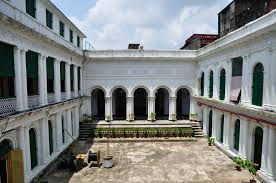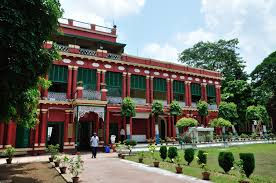INSIDE TAGORE’S JORASANKO 'THAKUR BARI'
- Arnabi Mallick
- May 20
- 3 min read
As the afternoon light filters through the ornate windows of Jorasanko Thakur Bari, casting honeyed patterns across polished wooden floors, one cannot help but feel the weight of cultural significance that permeates every corner of this stately mansion

Nestled in North Kolkata's bustling university district, this magnificent 18th-century ancestral home of the Tagore family stands as a testament to Bengal's intellectual renaissance and the extraordinary life of Asia's first Nobel laureate.
The imposing red façade, with its classical columns and elegant balconies, offers little hint of the creative ferment that once animated these halls. It was here, on 7 May 1861, that Rabindranath Tagore was born, the youngest of fourteen children in a family already renowned for its contributions to literature, music, and social reform. The estate, now preserved as Rabindra Bharati Museum, invites visitors to step through time into the world that shaped India's most celebrated polymath.
“Every room tells a story," explains my guide Sujata, her voice reverent as we climb the grand central staircase. “This was not merely a home but the epicentre of Bengal's cultural awakening."
The sprawling mansion, encompassing more than 35 rooms arranged around a series of courtyards, exemplifies the traditional Bengali thakur-bari (house of worship) architecture while incorporating European influences, a fitting physical embodiment of the synthesis between East and West that characterised Tagore's own philosophy.
On the first floor, meticulously restored living quarters offer intimate glimpses into the domestic life of the Tagore household. Rabindranath's modest bedroom, preserved with his original furniture, stands in stark contrast to the grandeur of the building itself. His writing desk, simple yet elegant, faces a window that once provided views of the garden where he often sought inspiration. It's a surprisingly humble space for a man whose works would transcend borders and generations.
Moving through the gallery halls, one encounters a treasure trove of memorabilia: original manuscripts with Tagore's distinctive handwriting; personal correspondence with luminaries like Mahatma Gandhi, Albert Einstein and W.B. Yeats; and a stunning collection of paintings that showcase his late-blooming talent as a visual artist. The family's private collection of European and Oriental art reflects their cosmopolitan outlook, whilst old photographs capture moments of both familial warmth and meetings of exceptional minds.

The museum's curators have struck a delicate balance between academic exhibition and emotional resonance. Glass cases display the Nobel Prize medal that Tagore received in 1913 for “Gitanjali," his collection of profound mystical poems. Nearby, one finds the heartbreaking documentation of personal tragedies that shaped his worldview, the early deaths of his mother, wife, and several children that influenced his deeply spiritual yet questioning literary voice.
In the southern wing, which once housed Tagore's father Debendranath's printing press, a special exhibition chronicles the family's involvement with the Brahmo Samaj religious movement and their progressive social reforms. The conversations that echoed through these rooms helped reshape Bengali society, challenging orthodoxies and championing women's education long before such ideas gained widespread acceptance.
What makes Jorasanko truly remarkable is how it contextualises Tagore not merely as an isolated genius but as part of a familial and cultural ecosystem. His brothers' contributions to art, literature and science; his nephew Abanindranath's pioneering work in reviving indigenous art traditions; the musical innovations that emerged from evening gatherings in the concert hall, all these elements create a richer understanding of the collaborative nature of Bengal's cultural efflorescence.
Visitors would be remiss to leave without experiencing the central courtyard at dusk, when students from the adjoining Rabindra Bharati University often practise Rabindra Sangeet, songs composed by Tagore himself. As these haunting melodies float through the evening air, one can almost imagine the young poet sitting beneath the ancient banyan tree, composing verses that would eventually become India's national anthem.
Jorasanko Thakur Bari is not merely a museum but a living monument to the enduring power of artistic vision. Within these walls, the past and present engage in constant dialogue, inviting visitors to connect with a cultural legacy that continues to inspire generations of writers, thinkers, and dreamers around the world.



